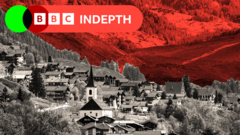In Switzerland’s picturesque Loetschental valley, Matthias Bellwald walks through the village of Wiler, a temporary hub for those displaced by a catastrophic landslide that obliterated the village of Blatten. Just two months prior, on a seemingly ordinary day, the mountain and its glacier collapsed, decimating Blatten—home to 300 residents. Evacuated just days before, the villagers lost not only their houses but all sense of normalcy.
Among the displaced is Lukas Kalbermatten, who recalls his family's centuries-old hotel now buried beneath tons of ice, mud, and rock. “The intimate essence of the village, my childhood memories, and every small detail… all gone,” he laments. Currently, he resides in borrowed accommodations, while efforts are underway to reconstruct his village by 2028, though plans come at an eye-watering price tag. The estimated cost for rebuilding Blatten could reach hundreds of millions, or about $1 million per resident.
In light of this disaster, public donations have poured in, but the broader question remains: is it worth it? Switzerland allocates nearly $500 million annually for natural hazard protection. Yet a parliamentary report from 2007 proposed that comprehensive safety measures could cost six times that amount—the viability of such expenditures is under scrutiny. The implications extend beyond financial burdens, as retaining these villages is intertwined with national identity, cultural heritage, and the essence of Swiss mountain life.
Switzerland’s Alps serve as the backdrop to its rich traditions, where each valley hosts its unique culture. However, with climate change exacerbating the frequency and unpredictability of landslides, the fate of many alpine villages hangs in the balance. While Blatten’s destruction shocked the nation, many Swiss residents are reluctant to acknowledge climate change’s role, characterizing the incident as an unusual occurrence.
Yet geologists like Matthias Huss emphasize climate change as a significant factor in Blatten’s downfall, linking the thawing of permafrost and glacial retreat to the region’s increasing geological instability. His warnings are echoed in research indicating that global warming is indeed altering the behavior and occurrence of landslides in high-altitude locales. Yet not every alpine community faces an immediate threat; some, like Brienz—which has remained under evacuation since instability signs appeared—remain in limbo.
These events provoke thoughtful debates regarding whether similar villages should be abandoned altogether. Editorials in Swiss media highlight growing public skepticism and examine the relationship between taxpayer-funded support for remote communities and the sustainability of such endeavors in an era of climate change.
One pivotal voice, Boris Previsic from the University of Lucerne, believes urgency is necessary for combatting the potential decline of these villages while remaining open to flexible solutions like relocation. He posits, “The mountain ultimately decides.”
Among the clean-up crews and volunteers involved in Blatten’s recovery, tales of camaraderie and resilience persist. Individuals who shared lifelong bonds in Blatten now connect as they navigate the harsh reality of their village’s destruction.
As the Swiss confront the realities of their transforming highlands, a bittersweet sentiment lingers: the enduring love for the mountains intertwines intimately with the fear of their volatility. With faces laden with determination, locals repeatedly embrace one another, each one echoing a simple but poignant truth: “We are still here.”





















